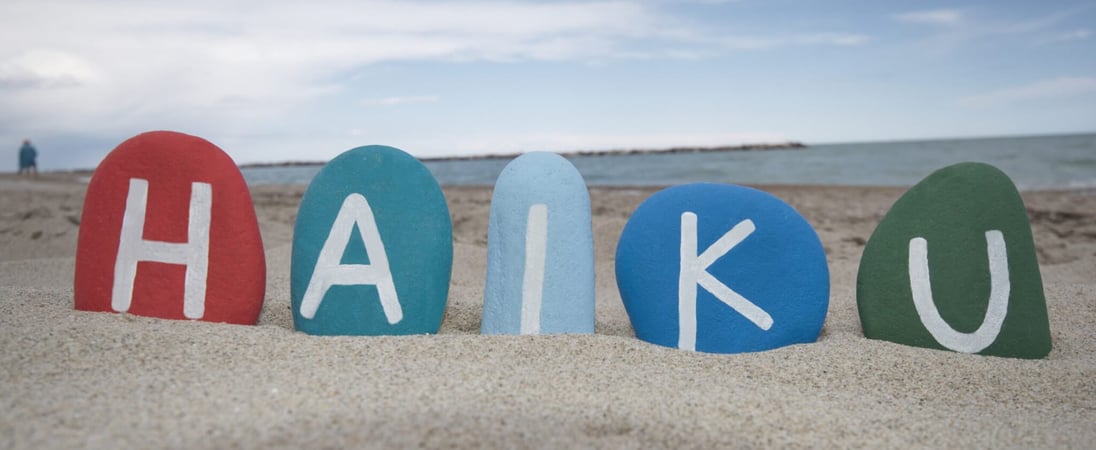
International Haiku Poetry Day
Write your own Haiku. Take in other poet’s works. Let Haikus move you.
It’s not so simple,
As writing five-seven-five,
But we think it is
If there is one special thing that certain people tend to remember from school, it’s the day that we were introduced to the great Japanese art-form that is Haiku.
While it may have an ancient and noble history, it is likely at it’s most ignoble when a group of young kids try to cobble together Haiku in series of five-seven-five! Still, just the act of being creative can be fun and exciting, whether young or old.
Haiku Day serves as a reminder that there is so much more to this style of poetry than a misspent week in high school literature classes.
Instead, it’s a day to celebrate the width and depth and breadth that can be enjoyed when words are limited but imaginations are allowed to soar.
So How Did Haiku Come to be in the West?
The man held responsible for this (and thus it appears in school curriculum books) was an unlikely Danish man named Hendrik Doeff.
As commissioner of trade in Nagasaki in the 19th century, he developed a love of the art of Eastern poetry. Although he managed to bring it to the West himself, in general it wasn’t greatly received at first. In fact, it took until the early to mid-1900’s for Haiku to appear in the English language.
No matter what language a person speaks or where they come from, Haiku is one where the number of syllables used in a poem can serve as a framework for some of the most beautiful pieces of art ever formed. And Haiku Day is just the day to celebrate and appreciate this!
How to Celebrate International Haiku Poetry Day
Celebrating Haiku Day centers all around the notion of poetry and beauty. Try these ideas to incorporate into the day:
Write a Haiku Poem
Get out a pen and paper, wander in and out of nature, and wait for something to bring a little bit of inspiration! Haiku Poetry is about the beauty that can be captured in short, simple stanzas.
With its unique style (five syllables on the first line, seven on the second, and five again on the third), anyone can write a Haiku poem.
However, it sometimes takes a true master to capture the heart and mind in the space of 17 syllables.
Read a Book of Haiku Poetry
For those who are feeling less inspired to create their own poetry, reading Haiku written by others is a great way to enjoy the day. Here are a few to get started with:
- Japanese Haiku Poems (2003) by Peter Washington
- The Haiku Anthology (1974) by Cor van den Heuvel
- The Essential Haiku (1994) by Robert Hass
- Haiku: Japanese Art and Poetry (2010) by Judith Patt
Learn a Bit of Japanese
For those who are feeling particularly adventurous (or for those who already know Japanese) get even deeper into the craft by trying to write in the original language.
Today, people who want to learn a new language have more opportunities than ever to access lessons through apps and online formats, as well as the ability to communicate with native speakers through the internet!
Try these ideas for learning Japanese:
- Duolingo. This free app is a great way to learn Japanese as it offers beginner and intermediate options. Learning comes through pictures, listening and repeating important key phrases about a variety of topics.
- Busuu. Another app for language learning, this one claims that 22 hours spent on the app are equal to an entire semester of college-level language learning. It includes full language courses as well as opportunities to converse with native speakers all over the world.
- I Will Teach You a Language. This method is very different in that it uses the power of story to not only teach the language but also give a peek into how to be a cultural insider.
International Haiku Poetry Day is a great opportunity to let your creativity flow, and really begin to appreciate the complexities of life refined down to simplicity. Who knows? You could become the next Haiku Master!
History of International Haiku Poetry Day
The history of International Haiku Poetry Day traces the origin of this beautiful, yet simple, form of poetry.
Haiku was originally found as the opening to another form of Japanese poetry called a Rengu. It took until the mid-1600’s for Hokku, the form Haiku was found in at this time, to start appearing independently from its parent form, Renga, and its Renku roots.
In the late 1800’s Hokku was renamed to Haiku when it appeared independently by the famous Japanese poet, author, and literary critic, Masaoka Shiki.
Although Shiki only lived a short 35 years, he is credited with the writing of almost 20,000 stanzas, which is quite an accomplishment. He was considered to be one of the first great Haiku Masters.
Two other masters who were responsible for elevating the form of Haiku poetry to an independent art form are Matsuo Bashō and Ueshima Onitsura.
These two were considered Masters of Poetry, and helped to promote Haiku so that it was appreciated and understood, even outside of its original context of Renku.
So important was Basho to the history of Haiku that he was considered to be a ‘Saint of Poetry’ 100 years after his death.
International Haiku Poetry Day FAQs
How did haiku evolve from collaborative linked-verse poetry?
Haiku originated as the hokku, the opening stanza of a collaborative linked-verse poem called renga.
Over time, poets like Matsuo Bashō began composing hokku as standalone poems, leading to the development of haiku as an independent form.
What role did Zen Buddhism play in the development of haiku?
Zen Buddhism influenced haiku by emphasizing simplicity, mindfulness, and a deep connection to nature.
This spiritual backdrop encouraged poets to capture fleeting moments and the essence of experiences in their verses.
How did haiku gain popularity outside Japan?
In the early 20th century, Western poets, particularly those in the Imagist movement like Ezra Pound, drew inspiration from haiku’s brevity and vivid imagery, incorporating its elements into their own works and thus introducing haiku to a broader audience.
What are some common misconceptions about writing haiku in English?
Many believe that English haiku must strictly adhere to the 5-7-5 syllable pattern.
However, due to linguistic differences, English haiku often focus more on capturing a moment or emotion succinctly, sometimes using fewer syllables.
How do haiku poets incorporate seasonal references in their work?
Haiku traditionally include a ‘kigo’ or seasonal word to indicate the time of year, grounding the poem in a specific context and evoking associated emotions.
What are some unique ways haiku is celebrated around the world?
In Nepal, organizations host haiku recitals featuring poets from various districts, emphasizing native languages. In Sri Lanka, poets gather to discuss haiku’s history and share their works, fostering a sense of community.
How has modern haiku evolved from its traditional form?
Contemporary haiku often move beyond traditional themes of nature and seasons, exploring urban life and personal experiences, and may not strictly follow the 5-7-5 syllable structure.
What is the significance of ‘kireji’ in haiku?
‘Kireji’ are cutting words in Japanese haiku that create a pause or break, adding depth and contrast to the poem’s imagery.
How did Masaoka Shiki contribute to the modernization of haiku?
Masaoka Shiki, a late 19th-century poet, reformed haiku by promoting a more realistic depiction of subjects and formally establishing haiku as an independent poetic form.
What are some fun facts about haiku’s influence on Western literature?
The brevity and imagery of haiku inspired the Imagist movement in early 20th-century Western poetry, leading to concise and evocative poetic forms.
See what else is happening…
There’s always more going on every month at Days Of The Year. Here are our favorites this month!
Also on ...
View all holidaysNational High Five Day
Give a high five to everyone, and let them know their accomplishments don’t go unnoticed. Whether your friend got a promotion or made a basket—high five!
World Hemophilia Day
For some 400,000 people, simple papercuts, nicks, and scrapes can actually be dangerous or even life-threatening due to a blood disorder known as hemophilia.
National Kickball Day
Revisit your childhood by gathering some friends, family, or co-workers and getting together a fun, light-hearted game of kickball. It’s not just for kids!
We think you may also like...
World Poetry Day
With words as paint and emotions as the canvas, verses come alive, painting stories of heart and soul, in a symphony of expression.
National Poetry Month
Lord Byron, Shel Silverstein, Emily Dickinson…you? Honor one of the richest literary forms by writing or reading poetry, learning about poets, or joining a community.
Rumi Day
Dive into one of history’s greatest wordsmiths, the 13th Century Persian poet Rumi who has become one of the most widely-read and oldest artists of all time.








